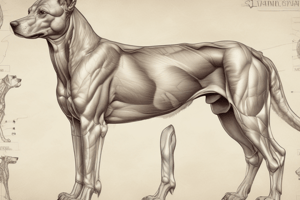Podcast
Questions and Answers
Where do the paraumbilical veins form a clinically important portosystemic venous anastomosis?
Where do the paraumbilical veins form a clinically important portosystemic venous anastomosis?
- Below the umbilicus
- Around the umbilicus
- Above the umbilicus (correct)
- Near the thoracic artery
Which veins connect to the portal vein in case of obstruction, leading to gross distension?
Which veins connect to the portal vein in case of obstruction, leading to gross distension?
- Paraumbilical veins (correct)
- Axillary veins
- Inferior epigastric veins
- Thoracic veins
Where do subcutaneous veins radiate from when producing the clinical picture called Caput Medusae?
Where do subcutaneous veins radiate from when producing the clinical picture called Caput Medusae?
- Around the umbilicus (correct)
- Around the thoracic area
- Around the axillary area
- Around the femoral area
To which nodes do veins above the umbilicus drain?
To which nodes do veins above the umbilicus drain?
Where do veins below the umbilicus drain into?
Where do veins below the umbilicus drain into?
Which artery is a branch of the external iliac artery?
Which artery is a branch of the external iliac artery?
What connects above into the axillary vein via the lateral thoracic vein?
What connects above into the axillary vein via the lateral thoracic vein?
Where do branches from intercostal, lumbar, and deep circumflex arteries go?
Where do branches from intercostal, lumbar, and deep circumflex arteries go?
Which veins connect to the femoral vein via superficial epigastric and great saphenous veins?
Which veins connect to the femoral vein via superficial epigastric and great saphenous veins?
Where do small veins form a clinically important portosystemic venous anastomosis?
Where do small veins form a clinically important portosystemic venous anastomosis?
Flashcards are hidden until you start studying
Study Notes
Abdominal Wall Anatomy
- Extent of the abdominal wall: superiorly, 7-10th costal cartilages and xiphoid process; inferiorly, pubic crest, iliac crest, and pubic symphysis
Layers of the Abdominal Wall
- Skin: loosely attached to underlying tissues, except at the umbilicus; capable of enormous stretching
- Superficial fascia: divided into two layers - fatty layer (Camper's fascia) and membranous layer (Scarpa's fascia)
- Deep fascia: thin layer of connective tissue covering muscles; lies immediately deep to superficial fascia
- Muscles: external oblique, internal oblique, transverse abdominis, and rectus abdominis
- Fascia transversalis: thin layer of connective tissue covering the muscles
- Extra peritoneal fascia: layer of connective tissue covering the abdominal cavity
- Parietal peritoneum: layer of peritoneum lining the abdominal cavity
Skin
- Umbilicus is a scar representing the site of attachment of the umbilical cord in the fetus
- Skin is capable of undergoing enormous stretching
Superficial Fascia
- Fatty layer (Camper's fascia): thick and continuous with the superficial fat over the rest of the body
- Membranous layer (Scarpa's fascia): thin and fades out laterally and above; fuses with linea alba and pubic symphysis in the midline; passes onto the front of the thigh and fuses with deep fascia of the thigh; enters the pelvis to become Colle's fascia
Deep Fascia
- Covers the muscles of the abdominal wall
- Lies immediately deep to the superficial fascia
- Anterior rami of the lower 6 thoracic and 1st lumbar nerves pass through the deep fascia
- Lower 5 intercostal and subcostal nerves pass through the deep fascia
Muscles
- External oblique muscle: originates from the lower 8 ribs; inserts into the xiphoid process, linea alba, and pubic tubercle; supplied by the lower 6 thoracic nerves, iliohypogastric, and ilioinguinal nerves; actions include supporting abdominal contents, assisting in forced expiration, and aiding in micturition, defecation, parturition, and vomiting
- Internal oblique muscle: originates from the lumbar fascia, anterior 2/3 of the iliac crest, and lateral 2/3 of the inguinal ligament; inserts into the lower 3 ribs and costal cartilages, xiphoid process, and linea alba; supplied by the lower 6 thoracic nerves, iliohypogastric, and ilioinguinal nerves; actions include supporting abdominal contents, assisting in forced expiration, and aiding in micturition, defecation, parturition, and vomiting
- Transverse abdominis muscle: originates from the lower 6 costal cartilages, lumbar fascia, and lateral 3rd of the inguinal ligament; inserts into the xiphoid process, linea alba, and pubic symphysis; supplied by the lower 6 thoracic nerves, iliohypogastric, and ilioinguinal nerves; action involves compressing abdominal contents
- Rectus abdominis muscle: originates from the pubic crest and symphysis; inserts into the 5th, 6th, and 7th costal cartilages and xiphoid process; supplied by the lower 6 thoracic nerves; actions include compressing abdominal contents, flexing the vertebral column, and aiding in expiration
Rectus Sheath
- Formed by the fusion of aponeuroses of the external oblique, internal oblique, and transverse abdominis muscles
- Encloses the rectus abdominis and pyramidalis muscles
- Also contains the superior and inferior epigastric vessels and the ventral rami of the lower 6 thoracic nerves
Arcuate Line
- A crescentic line that demarcates the transition between the aponeurotic posterior layer of the rectus sheath
- Begins approximately 1/3 of the distance from the umbilicus to the pubic crest
Linea Alba
- A tendinous median raphe between the two rectus abdominis muscles
- Extends from the xiphoid process to the pubic symphysis
- Formed by the fusion of aponeuroses of the external oblique, internal oblique, and transverse abdominis muscles
Studying That Suits You
Use AI to generate personalized quizzes and flashcards to suit your learning preferences.




